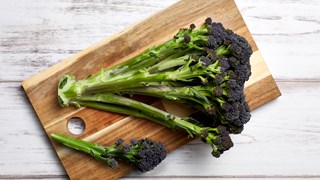Everything you've ever wanted to know about broccoli
The team that brought the nation Burgundy Broccoli has provided an indispensable guide for everything you’ve ever wanted to know about the nation’s beloved brassica!
David Clay, Brassica Crop Manager at Elsoms Seeds, shares his wealth of knowledge and first-hand insight into all things broccoli, by answering the important broccoli questions we’ve all been asking (accordingly to Google, of course).
1. Which part of broccoli is the healthiest?*
“Both the stem and florets of a broccoli contain similar nutrient content. Although broccoli stems are less colourful and flavoursome as the florets, the stem is just as nourishing and contains a near-identical nutritional value.
“The amount of nearly all B vitamins, minerals and fibre is similar. The stem contains slightly more calcium, iron and Vitamin C whilst the florets contain more vitamin A and beta-carotene – which is around seven times more abundant in the florets than the stem.”
2. Are broccoli stems edible?
“All parts of Burgundy Broccoli are edible, including the stem, florets and leaves. The stem from regular broccoli products is often discarded during the cooking process however, the stem contains much of the same nutrients as the broccoli head.
“Unlike typical broccoli varieties, Burgundy Broccoli is the world’s first ever whole head purple broccoli that is so tender you can eat the entire product, so it doesn’t need to be floreted. This means Burgundy Broccoli can be enjoyed as a whole, as well as producing less overall waste.
“Broccoli is full of vitamins, fibre, potassium, folate and more – making it an indispensable source of nutrients.”
3. Is broccoli a flower?
“Broccoli is a member of the brassica family, along with cabbage and cauliflower – the word ‘broccoli’ itself, derived from the Italian word broccolo means ”the flowering crest”.
“Within the cabbage family, broccoli is grown for its edible flower buds and stalk – its large, flowering head is eaten as a vegetable. Broccoli forms green clusters of flower buds, if left unharvested and these buds would develop yellow flowers with four petals and produce silique fruits.”
4. Which vitamins does broccoli contain?**
“Broccoli is a highly nutritious vegetable, containing a range of health-boosting vitamins and minerals. The valuable vegetable is high in a number of vitamins and minerals including potassium, folic acid, Vitamin A, C and K, as well as dietary fibre, all of which are essential for a nourishing and balanced diet.”
Vitamin K is essential for the functioning of many proteins involved in blood clotting.
Vitamin C builds collagen, which forms body tissue and bone, and helps cuts and wounds heal. It is also a powerful antioxidant and protects the body from cell damage.
Fibre promotes digestive health, having a high fibre intake can also help to lower cholesterol.
Potassium is a mineral and electrolyte that is necessary for the function of nerves and heart contraction.
Folate helps to produce and maintain new cells in the body.
5. Who discovered broccoli?***
“Broccoli is a manmade product – over 2,000 years ago, it was carefully bred by Italian farmers out of the wild cabbage plant, Brassica Oleracea. Broccoli was first introduced to England in the mid-18th century, then referred to as ”Italian asparagus.”
“Originally, the Etruscans, an ancient Italian civilization who lived in what is now Tuscany, were considered to be horticultural geniuses and engineered broccoli from a cabbage strain. The pioneers then cultivated broccoli to have a specific taste and flavour, that was more humanly palatable.”
 broccoli-2
broccoli-2